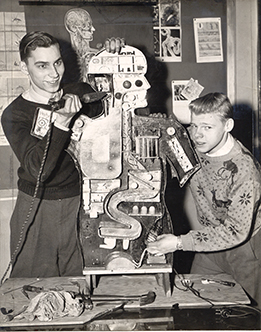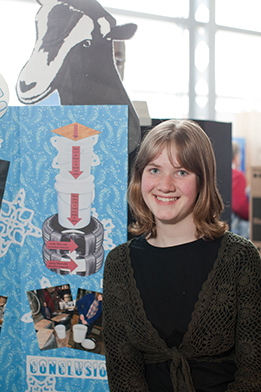 Summer 2014
Summer 2014|
A Legacy of Science
More than 50,000 students have tested their science mettle by competing at the annual Pittsburgh Regional Science & Engineering Fair.
“Oh, I still have parts of it at home,” George Guzik says, with a chuckle. The Westinghouse engineer, who’s been a PRSEF volunteer and judge for the past 18 years, describes how his “vortex tube” took in compressed air and then generated a flow of hot air and a flow of cold air. “It probably wasn’t the most impressive project, but it worked.” Gerry Vaerewyck, vice president of engineering at Vere, a New Kensington-based company that makes and sells laser systems and components, had no problem remembering his projects: “One year I produced alcohol from water hyacinths; another year my project was about measuring radiation; another year it was on smoking,” he says. “I identified dominant and recessive genes for ultraviolet pigments in fruit flies,” notes Rob Thompson, who went on to develop software for the insurance industry, launch his own software company, and then sell it to ITT. Today, he’s one of the region’s most passionate advocates for science learning and STEM (science, technology, engineering, and math) careers, serving on the Science Center board and establishing a family fund along with his wife, Diane, to support organizations that enhance STEM education initiatives in schools. Dolores Viehman—daughter of an engineer, who became an engineer in the ‘70s, married an engineer, and whose daughter participated in this year’s science fair and plans to become a third-generation engineer—had alittle help recalling her projects. “My father saved them,” she says. “When he passed away we found them in his house.” One of them looked at the byproducts of coal; another looked at temperature and how a thermometer performed when it was wet and when it was dry. According to Science Center estimates, a remarkable 50,000-plus students have participated in the science fair since its debut in 1939. This year’s event attracted 1,100 students in grades 6-12, representing 23 counties in western Pennsylvania, three counties in West Virginia, and one county in Maryland. Most student participants were finalists from their own school science fairs. But a lot has changed since the days when PRSEF literally took over the former Buhl Planetarium. “I remember being on the steps of a back stairwell with my project,” notes Vaerewyck, who participated from 1974 to 1980. Today’s PRSEF, which is a project of the Science Center’s Chevron Center for STEM Education and Career Development, takesplace in the Grand Hall of Heinz Field. And while it’s still an annual right of passage for science-minded students throughout western Pennsylvania, it’s also become serious business for young people looking to build careers in the sciences. “The regional science fair is central to our mission because it fosters a love of science in generations of young people, but also because it cultivates interest in STEM careers,” says Ann Metzger, The Henry Buhl, Jr., Co-Director of Carnegie Science Center, who adds that she and Co-Director Ron Baillie get “charged up” just walking through the fair’s massive exhibit areas. “The best are getting better, and they’ll be the ones
who will change the world.” - Rob Thompson, PRSEF AlumnusThe annual event now has scores of regional sponsors—a who’s-who of corporate and educational leaders who, like Metzger and Baillie and their team at the Science Center, get fired up about nurturing the STEM leaders of the future. This year’s presenting sponsors were California University of Pennsylvania, Chevron, FedEx Ground, Kennametal, The Grable Foundation, and United States Steel, and at least 40 more organizations supported PRSEF at other sponsor levels. All told, more than $1 million in cash awards, scholarships, trophies, and trips were distributed by participating organizations at the awards ceremony on March 29. Sponsors gave out more than 150 awards, and 18 colleges and universities literally vied for the attention of PRSEF’s senior competitors, awarding tens of thousands of dollars in scholarships. Hundreds of professionals from industry and academia also served as science fair judges, many returning year after year for the sheer pleasure of seeing the remarkable work of the doctors, engineers, scientists, software developers, and technology entrepreneurs of the future. “The teenage mind is still growing,” said David Pearlman, director of student aid at Penn State Altoona, as he announced his school’s scholarship awardees this year. “So we can’t wait to see what you do next year!” The sky’s the limit on what that could be, Thompson notes. The Thompsons are so enthusiastic about the science fair that this year they introduced their own PRSEF scholarship awards, which benefited two high school seniors. “The best are getting better,” he says, “and they’ll be the ones who will change the world.” Without a doubt, among this year’s best was Suvir Mirchandani, a ninth grader who impressed the judges with his “Fuzzy Logic Based Web Browser for the Disabled,” and then went on to compete in the Intel International Science and Engineering Fair (ISEF) in Los Angeles. But it was Suvir’s sixth-grade PRSEF project that had everyone talking at Heinz Field in March. After being inundated with paper in middle school, he got the bright idea to calculate how much less ink it would take to print a document using the Garamond font (with its thinner strokes) as opposed to other popular fonts, including the Times Roman font used at his school. The young science wiz eventually estimated that his school could save $21,000 a year and the U.S. government could save as much as $230 million annually by switching fonts. After receiving such a positive response to his initial research, last year Suvir created a video based on his cost-saving idea and entered it in another Science Center program, the i5 Digital Video Competition. This past March, his research findings were published in Science. And for a short time during the week of this year’s science fair, as his fellow competitors were standing their ground near their project boards, Suvir had to excuse himself to be interviewed by CNN. “I’ve reviewed some of the ISEF projects, and I just shake my head,” says science fair alumnus Guzik. “These young people are really doing impressive work.”
|
Andy Warhol, Revealed · Rockhound · Picture This · Small Prints, Big Artists · Special Section: A Tribute to Our Donors · Director's Note · NewsWorthy · Face Time: Catherine Evans · Artistic License: Home-field Advantage · Science & Nature: Big Blue · The Big Picture
 |
Copyright © 2017 CARNEGIE Magazine. All rights reserved. |


